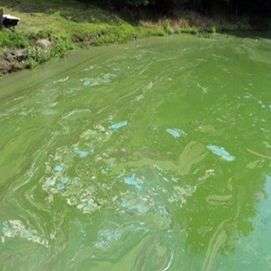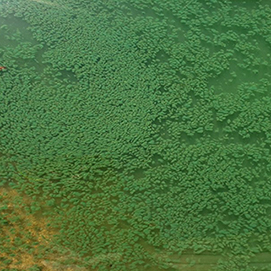Monitoring HCBs with the bloomWatch App
by Leah Hicks, NALMS Community-Based Science Intern
With the occurrence of harmful cyanobacteria blooms (HCBs) increasing throughout the world, it is of the utmost importance to increase community awareness about water safety when cyanobacteria are present. Cyanobacteria, commonly referred to as blue-green algae, are small bacteria found in waterbodies throughout the world. They are some of the earth’s oldest living organisms. When some cyanobacteria are found in high concentrations they form blooms, which are characterized by a discoloration of the water (often green/blue green, but these harmful blooms can also be red, brown, yellow, or pink). The resources on the NALMS Inland HABs webpage are a great way to learn more about these organisms.
If you live near or frequent a waterbody, consider participating in citizen science monitoring to help report and document any HCBs and changes in water quality! Citizen science is a way to educate communities about harmful algal blooms in areas where they often occur, and the U.S. Environmental Protection Agency (EPA) has released two applications that help aid in this effort: 1) the updated bloomWatch app and 2) the Cyanobacteria Assessment Network (CyAN) app. These apps aid in the reporting of and monitoring of HCBs and helps citizens raise awareness of, and monitor waterbodies for harmful algal blooms.
bloomWatch App
The bloomWatch app is designed for citizens who frequent water bodies in the area where they live and have an interest in maintaining good water quality. This application focuses on obtaining images of cyanobacteria blooms in water bodies throughout the world to better understand and document the occurrence and locations where HCBs occur. Citizens can use the bloomWatch app by installing it on their smart device, familiarizing themselves with what cyanobacteria blooms look like, and reporting any possible blooms by submitting a photo within the app. When using the bloomWatch app it is important to send any relevant information about HCBs to the appropriate local authorities as the application does not always share information with state/provincial agencies. The bloomWatch app can also be found on SciStarter, which is a platform that allows citizen scientists to participate in a wide range of research projects with self-guided training modules.
Cyanobacteria Assessment Network (CyAN) App
The CyAN app is designed primarily for water quality managers and state officials who make management decisions about the safety of recreational, agricultural, and drinking water supplies. The application works by using satellite data to detect and map algal blooms in water bodies that are one square kilometer or greater throughout the U.S. The data is then used by officials so that they can determine potential problem areas and make both fast and informed decisions about public safety and monitoring requirements. The CyAN app is an experimental app that is being used primarily as a research tool as it provides only provisional satellite measures of cyanobacteria blooms.
Both the bloomWatch and CyAN apps are great resources for citizens and officials to help monitor, report on, and increase sampling efforts on waterbodies that experience cyanobacteria blooms. bloomWatch and CyAN apps can be used together as the bloomWatch app is a source of information to validate the algal blooms detected by the CyAN app. Public databases, like the bloomWatch and CyAN apps, are great ways for scientists and managers to gather information on water quality from a large geographical range which enhances the diversity of data used in their research and their management decisions. These tools are also a great way for citizens to help monitor the health of the waterbodies, assisting scientists and managers obtain larger datasets, and permitting officials to obtain accurate and timely information on HCB in U.S waterbodies. Learn more about the desktop application for CyAN in the Summer 2021 issue of Lakeline.
Monitoring for HCBs in waterbodies is important due to the potential for the production of harmful cyanotoxins. Citizen monitoring and the use of public databases are one of the best ways to collect, inform and communicate information about HABs. Participation of citizens in water quality monitoring activities expands the number of lakes that are being monitored for HABs and allows for both analysis of long-term trends and comparison to nearby and similar waterbodies. In addition to the two apps mentioned here, there are many state and local cyanobacteria monitoring programs active in North America. The interactive cyanobacteria resource map on the NALMS Inland HABs webpage can help you find out what’s happening near you.
Common kinds of toxic producing cyanobacteria are Anabaena, Aphanizomenon, Cylindrospermopsis, Lyngbya, Nodularia, Oscillatoria, Trichodesmium, Microcystis, and Planktothrix [1]. HCBs significantly impact water quality in many ways, including decreasing water clarity and impairing recreational enjoyment, depleting waterbodies of dissolved oxygen (killing fish and other aquatic organisms that require oxygen) and even decreasing property values and impairing a region’s economic opportunities when there are beach closures. When a HCB is present advisories may be given to avoid drinking the source water or recreating in the waterbody, as cyanobacteria may produce potent nerve and liver toxins that can be harmful to humans and can kill pets and livestock consuming water along shorelines [2].
Cyanobacteria can be present in low densities in many waterbodies, but thrive in water that is warm, contains excess nutrients, and has slow or no current. The presence of excess nutrients (phosphorus and nitrogen) often results from human activities, including runoff from agricultural fields and urban landscapes, and discharges of wastewater effluents into waterbodies. With climate change increasing global temperatures and occurrence of heavy rainfalls, it is predicted that the occurrence of HCBs will increase [1]. Rise in global air temperatures is expected to increase the ice-free season, promote temperature stratification in lakes, and increase water temperatures. Heavy rainfalls will increase the amount of runoff and therefore increase nutrient runoff into waterbodies, especially when land is eroded due to flooding. An increase in global temperatures and rise in the occurrence of heavy rainfalls are just two of the many factors which will impact waterbody conditions that support cyanobacteria and HCBs [3].
Further Readings:
Check out these excellent resources and consider whether you can help document the appearance of HCBs:
- Drinking Water Webinar Series: https://www.nalms.org/habs-drinking-water-webinar-series/
- Learn about Cyanobacteria: https://www.nalms.org/inlandhabs/inlandhabs-learn/
- NALMS Inland Harmful Algal Blooms (HABs) Program: https://www.nalms.org/inlandhabs/
- Cyanobacterial Harmful Algal Blooms (CyanoHABs) in Water Bodies: https://www.epa.gov/cyanohabs
- LakeLine 41-2: Cyanobacteria Blooms: https://www.nalms.org/product/lakeline-41-2-cyanobacteria-blooms/
References:
[1]J. Huisman, G. Codd, H. Paerl, B. Ibelings, J. Verspagen and P. Visser, “Cyanobacterial Blooms”, Nature Reviews Microbiology, vol. 16, pp. 471-483, 2018. [Accessed 10 August 2021]. [2]”Health Effects from Cyanotoxins”, EPA, 2021. [Online]. Available: https://www.epa.gov/cyanohabs/health-effects-cyanotoxins. [Accessed: 11- Aug- 2021]. [3]”Causes of CyanoHABs | US EPA”, US EPA, 2021. [Online]. Available: https://www.epa.gov/cyanohabs/causes-cyanohabs. [Accessed: 11- Aug- 2021].

